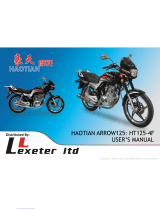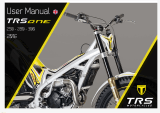ENGLISH
5
TABLE OF CONTENTS »
Page
IMPORTANT INFORMATION FOR PARENTS ABOUT SAFE
DRIVING . . . . . . . . . . . . . . . . . . . . . . . . . . . . . . . . . . .4
SERIAL NUMBER LOCATIONS . . . . . . . . . . . . . . . . . . . .6
Chassis number . . . . . . . . . . . . . . . . . . . . . . . . . . . .6
Engine number . . . . . . . . . . . . . . . . . . . . . . . . . . . .6
OPERATION INSTRUMENTS . . . . . . . . . . . . . . . . . . . . .7
Throttle grip . . . . . . . . . . . . . . . . . . . . . . . . . . . . . . .7
Hand brake lever . . . . . . . . . . . . . . . . . . . . . . . . . . .7
Short circuit button . . . . . . . . . . . . . . . . . . . . . . . . .7
Filler cap . . . . . . . . . . . . . . . . . . . . . . . . . . . . . . . . .7
Fuel tap . . . . . . . . . . . . . . . . . . . . . . . . . . . . . . . . .7
Choke (Dell’Orto carburetor PHVA 14 DS) . . . . . . . . . .8
Choke (Dell’Orto carburetor PHBG 19 BS) . . . . . . . . .8
Kickstarter . . . . . . . . . . . . . . . . . . . . . . . . . . . . . . . .8
Foot brake lever . . . . . . . . . . . . . . . . . . . . . . . . . . . .8
Side stand . . . . . . . . . . . . . . . . . . . . . . . . . . . . . . . .8
Plugin - Stand (50 SX, 50 Supermoto) . . . . . . . . . . . .9
Rebound damping function of the shock absorber . . . .9
General Tips and Warnings for starting the motorcycle .10
Instructions for the first ride . . . . . . . . . . . . . . . . . .10
Running in . . . . . . . . . . . . . . . . . . . . . . . . . . . . . .10
Driving instructions . . . . . . . . . . . . . . . . . . . . . . . . .11
What you should check before each start . . . . . . . . .11
Starting when the engine is cold . . . . . . . . . . . . . . .12
Starting when the engine is warm . . . . . . . . . . . . . .12
What to do when the engine is “flooded” . . . . . . . . .12
Starting off . . . . . . . . . . . . . . . . . . . . . . . . . . . . . .12
Driving . . . . . . . . . . . . . . . . . . . . . . . . . . . . . . . . .12
Refueling, fuel . . . . . . . . . . . . . . . . . . . . . . . . . . . .13
Braking . . . . . . . . . . . . . . . . . . . . . . . . . . . . . . . . .13
Stopping . . . . . . . . . . . . . . . . . . . . . . . . . . . . . . . .13
PERIODIC MAINTENANCE SCHEDULE . . . . . . . . . . . . .14
MAINTENANCE WORK ON CHASSIS AND ENGINE . . . .16
Removing the seat . . . . . . . . . . . . . . . . . . . . . . . . .16
Checking and adjusting the steering head bearing
(50 SX Junior) . . . . . . . . . . . . . . . . . . . . . . . . . . . .16
Checking and adjusting the steering head bearing
(50 SX, 50 Supermoto) . . . . . . . . . . . . . . . . . . . . . .17
How to change the handlebar position . . . . . . . . . . .17
Basic suspension setup for the weight of the driver . .18
To determine the sag of the shock absorber . . . . . . . .18
To determine the sag of the telescopic fork . . . . . . .18
Telescopic fork maintenance . . . . . . . . . . . . . . . . . .19
Changing the telescopic fork oil . . . . . . . . . . . . . . . .19
Cleaning the dust scrabbers of the telescopic fork . . .20
Page
Changing spring preloading of the shock absorber . . .20
Check chain tension . . . . . . . . . . . . . . . . . . . . . . . .20
Correct chain tension . . . . . . . . . . . . . . . . . . . . . . .20
Chain maintenance . . . . . . . . . . . . . . . . . . . . . . . . .20
General information about KTM disc brakes . . . . . . .21
Setting the basic position and play of the hand brake lever
.21
Checking the brake fluid level/ refilling . . . . . . . . . . .22
Checking front brake pads . . . . . . . . . . . . . . . . . . . .22
Replacing the front brake pads . . . . . . . . . . . . . . . .22
Changing the basic position of the foot brake lever
(50 SX Junior) . . . . . . . . . . . . . . . . . . . . . . . . . . . .23
Adjusting the control cable on the rear wheel (50 SX Junior)
.23
Checking the rear brake linings for wear (50 SX Junior)
.23
Drum brake maintenance (50 SX Junior) . . . . . . . . .23
Changing the basic position of the brake lever (50 SX,
50 Supermoto) . . . . . . . . . . . . . . . . . . . . . . . . . . . .23
Checking the rear brake fluid level (50 SX, 50 Supermoto)
.23
Refilling the rear brake fluid reservoir (50 SX,
50 Supermoto) . . . . . . . . . . . . . . . . . . . . . . . . . . . .24
Checking rear brake pads (50 SX, 50 Supermoto) . . .24
Replacing the rear brake pads (50 SX, 50 Supermoto)
.24
Removing and mounting the front wheel . . . . . . . . . .25
Removing and mounting the rear wheel . . . . . . . . . .25
Tires, air pressure . . . . . . . . . . . . . . . . . . . . . . . . . .26
Checking spoke tension . . . . . . . . . . . . . . . . . . . . .26
Cooling system . . . . . . . . . . . . . . . . . . . . . . . . . . . .26
Checking coolant level . . . . . . . . . . . . . . . . . . . . . .27
Cleaning the air filter . . . . . . . . . . . . . . . . . . . . . . .27
Exhaust system . . . . . . . . . . . . . . . . . . . . . . . . . . .27
Changing the seat height . . . . . . . . . . . . . . . . . . . . .28
Adjusting the throttle cable . . . . . . . . . . . . . . . . . . .28
Adjusting the idle speed (Dell’Orto PHVA 14 DS) . . .28
Adjusting the idle speed (Dell’Orto PHBG 19 BS) . . .28
Checking the gear oil level . . . . . . . . . . . . . . . . . . .29
Changing gear oil . . . . . . . . . . . . . . . . . . . . . . . . . .29
Adjusting the centrifugal clutch . . . . . . . . . . . . . . . .30
TROUBLE SHOOTING . . . . . . . . . . . . . . . . . . . . . . . . .32
CLEANING . . . . . . . . . . . . . . . . . . . . . . . . . . . . . . . . .34
STORAGE . . . . . . . . . . . . . . . . . . . . . . . . . . . . . . . . . .34
TECHNICAL DATA – ENGINE . . . . . . . . . . . . . . . . . . . .35
TECHNICAL SPECIFICATIONS - CHASSIS . . . . . . . . . . .36
HEAD WORD INDEX . . . . . . . . . . . . . . . . . . . . . . . . . .37
























